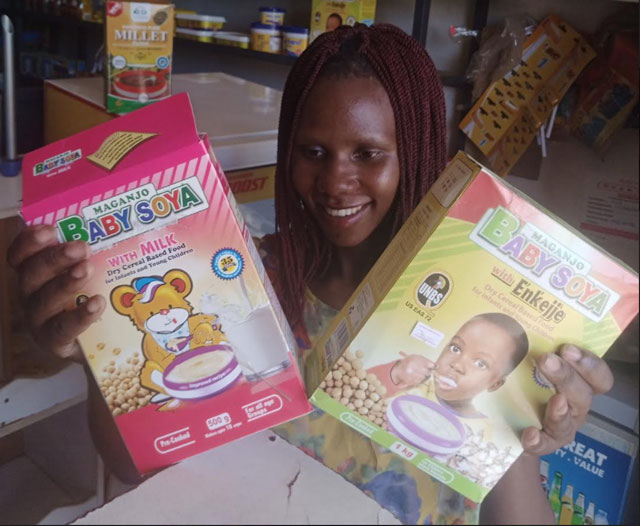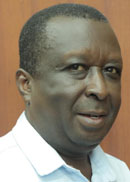
SPECIAL FEATURE | Alfred Geresom Musamali | Former President Apollo Milton Obote’s Agriculture, Forestry and Fisheries Deputy Minister Patrick Rubaihayo (84), who was recalled to his creator on Thursday 16th May has left behind a wife (Miriam), 11 children, 24 grandchildren and at least 20 major crop breeding research undertakings as listed by ResearchGate. Rubaihayo was a die-hard member of a political leaning from which some Ugandans would rather shun away. But fifty or more years from today, Ugandans and their animals may still be feeding on banana and soybean derivatives of Rubaihayo’s extensive research into the crops. His passion for soybean is quite recent but his earlier concentration was on banana.
Professor Florence Muranga, the proprietor of Presidential Initiative on Banana Industrial Development (PIBID) said it was Rubaihayo who first interested her in banana research in the late 1980s. PIBID is currently promoting “science-led processing and value addition enterprises” for a range of banana products such as flour for instant meal as well as for baking bread, cake and biscuit. The project aims to provide banana farmers with access to local, regional and international markets. Dr Muranga narrated during the funeral service held at Makerere University how the late professor hand-held her after she returned from exile in the 1980s and courtiously pointed out to her that banana research was Uganda’s way to go. The result is that President Yoweri Museveni bought into Muranga’s ideas and invested billions of the taxpayer’s funds into Dr Muranga’s Bushenyi based project – well, frequently despite a spirited opposition from Parliament.
Yet Makerere University Professor Emeritus Rubaihayo could be a steadfast political pain in the neck of both the Museveni Government and the leadership of the Uganda People’s Congress (UPC), Dr Obote’s party now led by Obote’s son, Lira Municipality MP Jimmy Akena.
Rubaihayo and Haji Badru Wegulo (RIP), for instance, spearheaded the authoring of a “hot-potato” political document that earned them rent-free residence at the lakeside Luzira Maximum Security Prison around 1996. Wegulo was UPC National Party Chairman in 1985 when the UPC Government under Dr Obote was overthrown in an internal military coup and, after quite some fracas, Museveni, who had fought the government in a four year bush war, rose to power. When Rubaihayo and Wegulo did come out of Luzira, according to Rubaihayo’s former Makerere academic Fred Oweyega Afunaadula, Wegulo, however, started “walking zigzag”, with one leg in the then exiled Dr Obote’s UPC while the other was suspectedly in President Yoweri Museveni’s National Resistance Movement (NRM). With time, says Afunadula, Wegulo was formally appointed a Museveni presidential advisor of sorts and jumped ship. But Rubaihayo remained steadfastly UPC till his demise. Of late, Rubaihayo has been Chairman of the Milton Obote Foundation (MOF), the business wing of UPC which sometimes has a love-hate relationship with the party. Rubaihayo and party lawyer Peter Mukidi Walubiri have checked every move by Jimmy Akena – whose wife Betty Amongi is minister in the Museveni Government – aimed at establishing full legitimacy over both the party and the foundation.
Outside politics, though, Rubaihayo was a master of scientific research collaboration. One of his most enduring collaborations was with fellow Makerere University College of Agriculture and Environmental Sciences academics Clever Mukuze, Phinehas Tukamuhabwa, Hellen Kongai and Tonny Obua in soybean research. Others in the team were Shorai Daris from the University of Zimbabwe Faculty of Agriculture and Mcebisi Maphosa from Zimbabwe’s Lupane State University Faculty of Agriculture.
A ResearchGate report says “The researchers in 2020 noted that soybean is an important food and cash crop in Uganda but that despite its importance, its performance was highly affected by genotype and interaction with the environment, making it difficult to select and recommend new superior soybean genotypes for diverse growing environments”.


In Uganda, soybean is roasted and eaten as a snack, especially in boarding schools where it competes with mberenge (roast dry maize) and njugu mkarango (roast groundnuts). But in households, the protein, amino acid and fibre-rich soybean is also pounded and mixed with vegetables to make a gravy, in the same way as the households use groundnuts and simsim.
Industrially, soybean is ground and mixed with either Nkejje or Mukene (types of silver fish) or with milk to make baby food. Treated as an inferior fish among some elite Ugandans, the small fishes are high in calcium and protein, wonder nutrients in the treatment of malnutrition. Vegetable oil is also extracted from soybean and the high-protein fiber that remains is toasted and prepared into animal feed for poultry, rabbitry, piggery, cattle, fish and pets.
According to the ResearchGate report, entitled “Evaluation of the performance of advanced generation soybean genotypes using GGE biplot,” Rubaihayo and other researchers were dissatisfied with the yield of the soybean crop in Uganda. The researchers, therefore, “designed a study to examine how the nature of genotype and its interaction with the environment affected the soybean grain yield. They also sought to identify stable and high yielding soybean genotypes with desirable percentage of protein and oil content for production in diverse environments and to determine ideal test location for future soybean breeding activities in Uganda”.
The experiment was conducted at six locations for two consecutive seasons of year 2018 (2018A and 2018B). The locations were Abi (West Nile), Bulindi (Western Uganda), Iki Iki (Eastern Uganda), Kabanyoro (Greater Kampala), Ngetta (Northern Uganda) and Nakabango (Mid-Eastern Uganda). The characteristics of each location in terms of geographical coordinates, altitude, mean annual temperatures, mean annual rainfall and soil type are outlined in the table below.

According to the table, Iki Iki (01o 06’ N) had the third lowest altitude (1156 Metres Above Sea Level), the second highest mean annual temperatures (28oC), the lowest annual rainfall (1200mm) and sandy soils while Bulindi (01o 28’ N) had the second highest altitude (1300 Metres Above Sea Level), the second lowest temperatures (23oC), high annual rainfall (1700mm) and sandy loam soils.
Twenty-three newly advanced generation soybean lines (named BSPS series) and two commercial varieties were planted in three blocks randomly selected in the six locations during the two seasons. An analysis was carried out for grain yield as well as for percentage protein and oil content. The results of this research, though too complicated for the ordinary farmer, may form the basis of agricultural expert recommend to farmers on what type of soybean to grow in which part of Uganda.
For instance, the researchers point out, “….only four mega-environments with their winning genotypes located at the vertices of the polygon were identified. Locations Kabanyolo, Bulindi and Nakabango were classified on mega-environment I, in which BSPS 48A-28 was the winning genotype. Megaenvironment II had Iki-Iki with BSPS 48A-28-1 as the winning genotype, Ngetta was classified on megaenvironment III where genotype Bulindi 18.4B was the most adapted. Mega-environment IV had Abi found in the West Nile region where BSPS 48A-24-1 was the winning genotype, indicating that Uganda had broad agroecological regions with unique environmental characteristics with specific suited high yielding genotypes.
The researchers established that, “Location Bulindi had the highest mean yield of 2650 kg/ha, while Iki-Iki had the lowest mean yield of 889 kg/ha. The reason is Bulindi received high rainfall (1700 mm/ annum) and the site has good soil types, with good nutritional status and water holding capacity”.
“They agreed with Tukamuhabwa et al. (2012) that the reason for low yielding in Iki-Iki might be the gradual changes in biotic and abiotic factors from season to season.They concluded, again like Tukamuhabwa et al. (2012) that, on the other hand, Iki-Iki is characterized by poor sandy soils, with low water holding capacity.
They also agreed with “Ibanda et al. (2018), Iki-Iki is a hotspot for groundnut leaf miner, a new soybean pest which is devastating soybean in Uganda. Despite the relatively low yield potential for soybean in Iki-Iki, genotype BSPS 48A-28 managed to maintain its average performance implying that this genotype had good dynamic stability”.
This is a good attribute, they said, for any commercial variety given the unpredictable patterns of biotic and abiotic factors in most parts of the country. The researchers that “recommendation typically based on any single location was unreliable because there is differential response of genotypes across locations”.
They said the most stable and high-yielding genotype was BSPS 48A-28 probably due to having lowest groundnut leaf miner damage, rust scores, high number of pods, is late maturing and, based on mean yield and stability, maintained its above average performance in most of the environments.
Rubaihayo, who represented Mbarara Central in Parliament between 1980 and 1985, was buried at his ancestral village Rwenshanku, Kashari in Mbarara district on Sunday May 19th. There goes our man! There goes a fellow who, despite dribbling in politics, had something else positive to leave for posterity! Fare thee well, Banana and Soybean Professor! Fare thee well, Dr Rubaihayo!
*******

The author is Founding Director of Vicnam International Communications Ltd, a private firm of communications, public relations and information management consultants. He specialises in the Proofreading and General Editing (PAGE) of documents and can be contacted by Tel: (+256)752-649519 and by Email: agmusamali@hotmail.com.
 The Independent Uganda: You get the Truth we Pay the Price
The Independent Uganda: You get the Truth we Pay the Price



